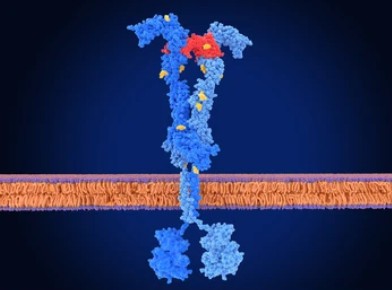Vascular Endothelial Growth Factors (VEGFs)
Related Symbol Search List
Immunology Background
About Vascular Endothelial Growth Factors (VEGFs)
Vascular endothelial growth factor (VEGF), also known as vascular permeability factor (VPF), plays a key role in angiogenesis. VEGF is produced by a variety of cell types, including tumor cells, macrophages, platelets, keratinocytes, and renal lining cells. They bind to specific cell surface receptors, primarily the vascular endothelial growth factor receptor (VEGFR), which are present in endothelial cells and other cell types, including hematopoietic stem cells. VEGF binding to its receptors initiates signaling cascades that regulate cellular responses, including proliferation, survival, migration, and differentiation. VEGF activity is not limited to the vascular system but also plays a role in normal physiological functions such as bone formation, hematopoiesis, wound healing, and development. Hematopoietic stem cells are capable of giving rise to all blood cell lineages and are usually found in clusters with endothelial cells (endothelial cells are a key cell type involved in blood vessel formation). In hematopoiesis, VEGF has been shown to have multiple effects on hematopoietic stem cells and the bone marrow microenvironment.

Functions of VEGFs
Vascular Endothelial Growth Factors (VEGFs) are a group of growth factors that play crucial roles in the regulation of angiogenesis (the formation of new blood vessels) and vascular function. They are primarily involved in the development, maintenance, and repair of the vascular system. Here are some key functions of VEGFs:
- Angiogenesis
VEGFs are potent stimulators of angiogenesis. They promote the proliferation, migration, and tube formation of endothelial cells, which are the building blocks of blood vessels. VEGFs induce the sprouting and branching of new blood vessels from pre-existing ones, ensuring adequate blood supply to tissues during development, wound healing, and tissue repair.
- Vascular Permeability:
VEGFs play a role in increasing vascular permeability, allowing plasma proteins and immune cells to pass through the blood vessel walls. This function is particularly important in inflammatory responses and tissue repair, where increased permeability facilitates the delivery of immune cells and growth factors to the site of injury.
- Development of Blood Vessels
VEGFs are essential for the development of the embryonic vascular system. They regulate the formation of major blood vessels and capillary networks during embryogenesis. VEGFs guide the migration and differentiation of endothelial cells, contributing to the establishment of a functional vascular network that supports organ development.
- Neovascularization
VEGFs are involved in the process of neovascularization, which refers to the growth of new blood vessels in response to ischemia (insufficient blood supply) or tissue damage. VEGFs promote the recruitment and proliferation of endothelial cells, initiating the formation of collateral vessels to improve blood flow to ischemic or injured tissues.
- Vascular Homeostasis
VEGFs play a role in maintaining vascular homeostasis, ensuring the proper functioning of blood vessels. They regulate the tone of blood vessels, promote vasodilation, and inhibit vasoconstriction. VEGFs also contribute to the maintenance of the endothelial cell barrier function, preventing excessive leakage and edema formation.
- Lymphangiogenesis
Some members of the VEGF family, such as VEGF-C and VEGF-D, are involved in lymphangiogenesis, which is the formation of lymphatic vessels. These VEGFs stimulate the growth and maturation of lymphatic endothelial cells, facilitating the formation of functional lymphatic vessels that drain fluid and immune cells from tissues.
- Tumor Angiogenesis
Dysregulation of VEGF signaling is frequently observed in cancer, and VEGFs contribute to tumor angiogenesis. Tumor cells can produce high levels of VEGFs, promoting the growth of blood vessels into the tumor mass. This process supplies nutrients and oxygen to the tumor, facilitating its growth and metastasis.
- Neuroprotection and Neurogenesis
VEGFs have neuroprotective effects on the central nervous system. They promote the survival and maintenance of neurons, enhance neuronal plasticity, and stimulate neurogenesis (generation of new neurons). VEGFs also play a role in the recovery and repair of damaged neural tissues.
Overall, VEGFs are critical regulators of angiogenesis and vascular function in various physiological and pathological processes. Their functions extend beyond the vascular system, impacting tissue development, repair, and maintenance in different organs. The therapeutic manipulation of VEGF signaling is a promising approach for various conditions, including ischemic diseases, wound healing disorders, and cancer.
Reference:
- Gerber, Hans-Peter, Malik, et al. VEGF regulates hematopoietic stem cell survival by an internal autocrine loop mechanism[J]. Nature, 2002, 417(6892):954-954.
- Gerber H P, Ferrara N. The role of VEGF in normal and neoplastic hematopoiesis[J] Journal of Molecular Medicine: Official organ of the "Gesellschaft Deutscher Naturforscher und Arzte.", 2003(1):81.
- Shalaby, Fouad, Rossant, et al. Failure of blood-island formation and vasculogenesis in Flk-1-deficient mice [J] Nature, 1995.
- Bae D, Mondragon-Teran P, Hernandez D, et al. Hypoxia Enhances the Generation of Retinal Progenitor Cells from Human-Induced Pluripotent and Embryonic Stem Cells[J]. Stem Cells & Development, 2012, 21(8):1344-1355.
- Salvucci O, Jiang K, Gasperini P, et al. MicroRNA126 contributes to granulocyte colony-stimulating factor-induced hematopoietic progenitor cell mobilization by reducing the expression of vascular cell adhesion molecule 1[J]. Haematologica, 2012.

